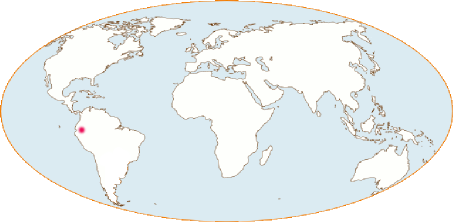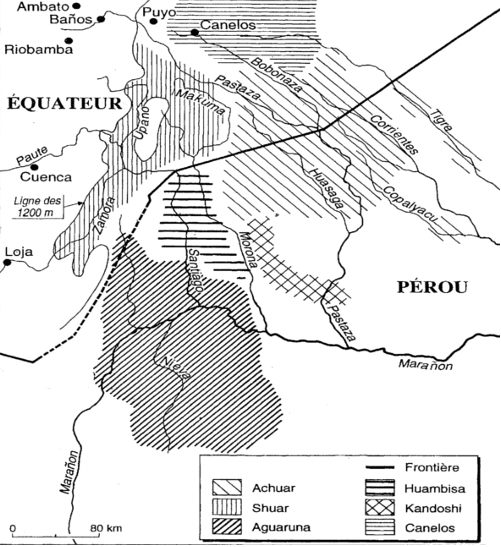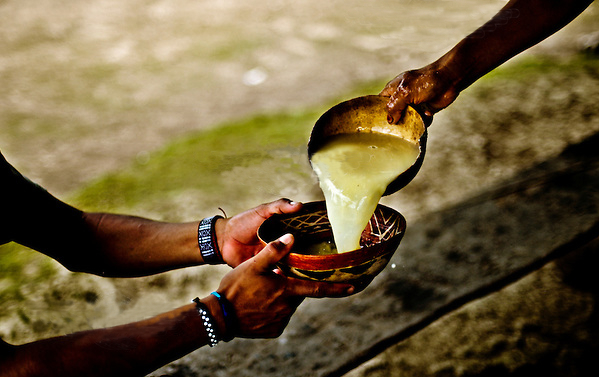Your search results [5 articles]
The cosmic beer of the Achuar (Jivaro) of Ecuador.
Straddling Ecuador and Peru, the great Jivaroan family includes the Shuar, the Ashuar, the Aguaruna and the Huambissa. Until recently (around 1970) the Achuars had suffered little from the consequences of the colonisation front, unlike the Shuars forcibly settled on Peruvian soil by the American Methodist churches. Their terrifying and unfounded reputation as human head reducers protected them as much as the isolation of the upper Amazon basin. Unlike the Shuar, the Ashuar have given up this custom.
Some 70,000 to 80,000 Jivaros are spread to the east of the Andean Cordillera over an area the size of Belgium. They live along the Marange river, in the middle of the Amazon basin. The low population density reflects their habitat, their semi-sedentary life and in part their conception of the world. The Achuars proper were about 5.000 in 1970[1].
The Achuars practice the clearing and burning to grow sweet cassava and vegetable plants. In this way, they settle for a few years along the watercourses, then move further away when the soil is exhausted. The very limited seasonal variations can be summed up by the lower rainfall from September to January.
The Achuars fish and hunt. Their diet depends on the seasons. During lowest waters, between August and January, fishing is abundant. In March begins the "time of the woolly monkey fat", a period of abundant fruit, well-fed wild animals and fruitful hunts. Cassava is grown all year round in the gardens. It is the indispensable basis for brewing the cassava beer appreciated by the Achuars. Beer is not only their daily beverage. This fermented beverage conveys powerful symbols: the cassava, the tumultuous fermentation of the beer and the joyful drunkenness. Each of its traits is matched with an element of their cosmogony.
The Amerindians of the Jivaro ethno-linguistic family all know the sweet cassava beer. Cassava is the central food plant of the Amazon basin. Cassava beer is called nijiamanch among the Jivaro people.
The peculiarity of the Jivaros lies in their proximity to the Amerindian peoples of the Andes Cordillera, at the height of the Equator, who cultivate corn, potatoes and quinoa, from which they make their own beers (akha in Quechua). The cultivation of cereals and grasses is more adapted to the Andean valleys, that of cassava to the Amazonian tropical climate and its dense forest.
Au début de la colonisation espagnole des pays andins, les bières de grains ont été baptisées chicha, mot hispano-quechua forgé au 16ème siècle pour désigner toutes les bières amérindiennes. Les Espagnols n'avaient pas de mot pour nommer ce groupe de boissons fermentées si étrangère à leurs coutumes [2]. De leur côté, les peuples amérindiens d'origines ethnolinguistiques différentes se sont trouvés en contact économique direct avec l'autorité coloniale espagnole, après la chute du pouvoir central des Incas vers 1530. Les villes de l'empire inca sont devenues des cités coloniales (Lima, Quito, Potosi) où se côtoyaient amérindiens, métis et colons espagnols. Les bières amérindiennes étaient vendues aux colons. Les amérindiens d'origine et de langue diverses ont eu besoin de forger un créole quechua-aymara-espagnol pour pratiquer ce petit commerce de brasserie. Les bières traditionnelles de maïs, quinoa et pomme de terre ont été baptisées chicha; le brassage et la vente de chicha se sont appelés chicheria (See Global History).
The marginalisation of Amerindian cultures has done the rest in Spanish and Mestizo literature. Modern literature uses the word "chicha" to encompass all the Amerindian beers of the continent, those of corn, quinoa, manioc, sweet potato or taro, and at the same time the manioc beer of the Jivaros peoples.
We must stick to the term jivaro nijiamanch by which the Achuars name their sweet cassava beer. Behind this word lie their beer drinking manners, their way of brewing it, theirs social rules that involve beer, and even their cosmologies that are peculiar to the universe of the Ashuar or common to the Jivaros. The colonial generic "chicha" blurs the tracks and leads to abusive comparisons. What is common between the "chicha" within the imperial political organisation of the Incas and the "chicha" of a no-state society like that of the Achuars?
[1] The idyllic picture of Amerindian ethnic groups preserving their way of life should not hide the reality. Multinational oil, mining, timber, rare metals and agro-food companies are ravaging their territories. Lead and cadmium pollution contaminates the soil and accumulates in the blood of the Shuar, causing diseases, deformities and abortions. The physical and cultural extermination that the Spanish conquistadors failed to achieve will be carried out by these multinationals, under the watchful eye of governments and the billions of consumers whose needs they satisfy (petrol, smartphones, vegetal oils, ...).
[2] Cerveza will be of a later use and reserved for industrial beer, first imported from Europe and then brewed locally. The Spanish language relations of the 16th century use more readily the periphrase "vino de maiz" to refer to maize beers, before the generic "chicha" became established.





